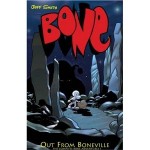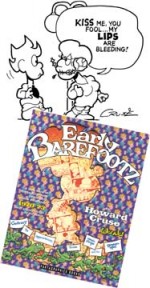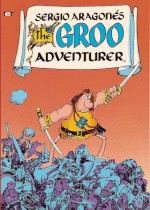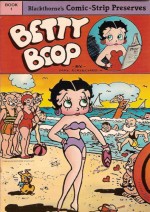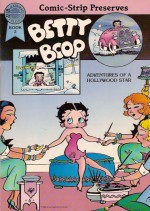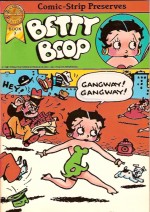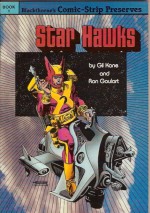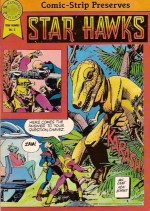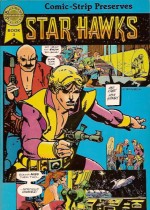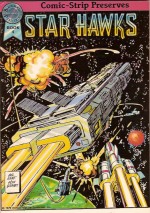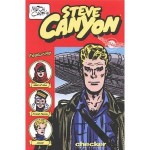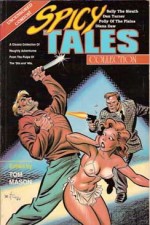
By various, compiled and edited by Tom Mason (Malibu Graphics)
ISBN: 0-944735-32-0
Before the birth of the American comic-book industry the most popular mass-market home-entertainment was reading and a vast market of cheap, readily accessible pulp magazines provided escapist literature on every subject for every genre imaginable.
There’s no real artistic or literary justification for today’s featured item, and I’m not even particularly inclined to defend some of material within on historical grounds either. Not that there isn’t an undeniable and direct link between these enchantingly tawdry vignettes and today’s comic book market of age-and-maturity-sensitive cartoons, and when taken on their own terms the stories do have a certain naively beguiling quality. Moreover the rather seedy little strips gathered here are an early turning point for the American branch of our industry for the plain and simple reason that they singled out and were aimed at grown-up readers of picture strips at a key moment before comic book even existed.
The story of how Max Gaines turned freebie pamphlets containing reprinted newspaper strips into a discrete and saleable commodity thereby launching an entire industry, if not art-form, has been told far better elsewhere, but I suspect that without a ready public acceptance of serialised sequential narrative via occasional book collections of the most lauded strips and these saucy little interludes in the all-pervasive but predominantly prose pulps, the fledgling comic-book companies might never have found their rabid customer-base quite so readily.
There were pulps for every possible genre and topic including racier “men’s adventuresâ€; two-fisted exotic action-thrillers heavy on mildly fetishistic sadism and bondage themes, with rugged American men coming to the rescue of white women in peril from thugs and foreigners and especially saving them (the white women, of course) from “fates worse than deathâ€, but only just in time and never before they had lost most of their clothes (the girls – well actually the Rugged American too, in many cases…). How much better than words then would a pictorial adventure seem?
One publisher in particular specialised in this niche market, producing a range of saucy genre thrillers all graced with a defining appellative: Spicy Detective, Spicy Western, Spicy Mystery and Spicy Adventure Stories. This was printer-turned-publisher Harry Donenfeld, who assumed control of some companies who couldn’t pay their print bills in 1934 and knowing pretty well what readers liked, created a Men’s Mag mini Empire under the twin banners of Culture and Trojan Publications. Of course, that’s also how he assumed control of the companies that became DC Comics less than a decade later, but the flak that eventually accrued to Trojan and Culture dictated a diametrically opposing editorial policy in 1940…
In 1943 the pressure exerted by various censorious elements in America became too much and the Trojan/Culture company changed tack and “Spicy†overnight evolved into “Speed Detectiveâ€, “Speed Western†and so forth…
This cheap and cheerful black and white compilation, neatly packaged behind a delightful Bruce Timm cover, features a couple of fascinating and informative assays from Tom Mason and John Wooley who provides background for each of the star turns revived here. The art for all of these strips was supervised if not provided by Adolphe Barreaux, through his own Majestic Studios Art “Shop†and these strips were first re-surfaced in Malibu’s Eternity Comics imprint Spicy Tales in 1989.
The major portion of this book features 24 tales of Sally the Sleuth, feisty special agent who debuted in the torrid two page yarn ‘A Narrow Escape’ wherein she lost all her clothes, but not her dignity, and with vagabond boy wonder sidekick Peanuts saved the day against vile gangsters.
Format firmly established they went on to tackle burlesque-murderers, white-slavers, fashion-poisoners, trial-tamperers, mad scientists, foreign devils and assorted criminal scum in such startling visual vignettes as ‘The Dart of Death’, ‘Crimson Menace’, ‘The Torso Murder’, ‘Maid to Order’, ‘The Spider’ and ‘Toy of Fate’. The stories are slick and minimalist, playing heavily on prevalent racial and sexual stereotypes of the era but well constructed and devilishly moreish, spanning November 1934 to October 1940.
Sally even graduated to proper comic-books for a while in the 1950s anthology Crime Smashers, drawn as ever by Barreaux.
The adroit and prolific artist also illustrated Dan Turner – Hollywood Detective, who began life as a prose gumshoe in Spicy Detective, becoming so popular that he graduated to his own title, winning himself a comic strip feature into the bargain. He even became the star of his own Tinseltown movie “Blackmail†in 1947.
The novellas and strip were written by the stunningly prolific pulp-writer Robert Leslie Bellem and the decadent glamour of Turner’s profession and location afforded the movie-land mystery-solver a longevity denied to his generally underdressed co-stars here. I don’t recall him ever having to get his kit off either…
Turner also got substantially more room to solve his pictorial puzzles – usually 6-8 pages per episode – and is represented here 5 early cases: ‘The Murdered Mummy’, ‘Murder With Music’, ‘Zoot Suit Killers’, ‘Killer’s Foil’ and ‘Sinister Santa Claus’ all culled from Spicy Detective between January 1943 and October 1944.
One of the most intriguing and disturbing strips came from Spicy Western Stories, and launched relatively late – November 1936. Polly of the Plains was a decent girl called from the civilised East into the Wildest of Wests to manage a homestead in trouble. Once there she undergoes kidnap by Mexican bandit Pancho, is whipped, chained, tortured and generally abused for a year by all the bad things cowboy fiction contains, until the feature was abruptly dropped mid-cliffhanger in December 1937.
The first two strips were drawn by the ever-so-young Bill Everett (who would find immortality creating Amazing Man and Sub-Mariner) a few years later, then taken over by Joseph Sokoli who eschewed Everett’s mild but pretty innuendo for a far more raw, racy and graphic (mis)treatment of the harassed heroine. The strips reprinted here cover the first half of the run.
The final distressed damsel on show is Diana Daw whose fantastic exploits debuted in Spicy Adventure Stories in November 1934; the tale of a far less innocent, more competent African explorer who stumbled into a lost world of barbarian natives, hidden kingdoms, knock-off Tarzans and a forgotten colony of Crusaders. Diana gets stripped and tied up an awful lot but is by no means a frail female – she revels in her naked savagery and kills as many attackers – be they Ape, Arab or Aborigine – as any of her brawny he-men admirers…
The seven 2-page serial instalments reproduced here show a woman far more in keeping with post-millennium attitudes, most probably crafted by writer Robert Maxwell (who wrote for the Superman Radio and TV shows as well as scripting the 1951 movie Superman and the Mole Men) and illustrator Max Plaisted, collaborating under the pen-name Clayton Maxwell. The episodes here run from the introductory chapter until June of 1935.
Hard to find, difficult to justify but inarguably a vital stepping stone to our modern industry there is a rough, guilty gratification to be found in these undeniably effective little tales. This book and the era it came from are worthy of far greater coverage than has been previously experienced and no true devotee can readily ignore this stuff.
© 1989 Malibu Graphics, Inc. All Rights Reserved.


